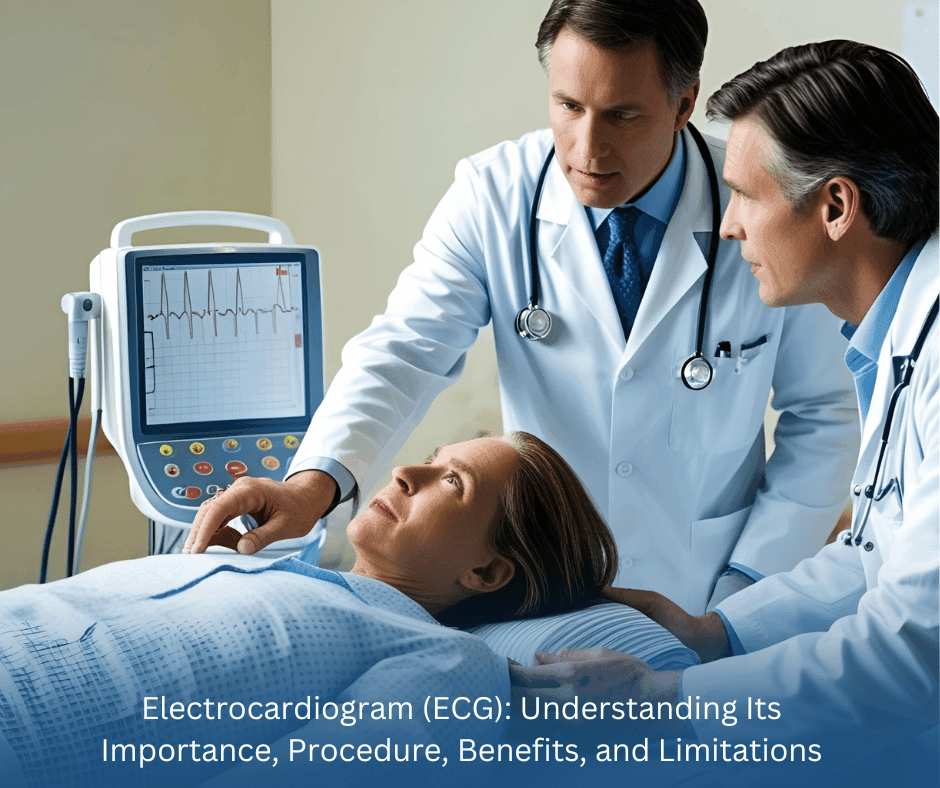Electrocardiogram (ECG): Understanding Its Importance, Procedure, Benefits, and Limitations
Introduction
The electrocardiogram (ECG or EKG) is a simple yet crucial diagnostic tool that records the electrical activity of the heart. It is widely used by healthcare professionals to detect heart conditions, monitor heart health, and guide treatment decisions. Given the increasing prevalence of heart diseases worldwide, understanding ECGs and their role in cardiac health is essential.
This blog post will explore the fundamentals of ECG, how it works, its advantages, limitations, and its significance in diagnosing heart conditions.
What is an ECG?
An electrocardiogram is a test that measures the electrical impulses that control the heart’s activity. These electrical impulses coordinate the heart’s rhythm, enabling it to pump blood effectively. ECG results are typically displayed as a waveform on paper or a digital monitor, showing various peaks and troughs representing different phases of the cardiac cycle.
ECG tests are non-invasive, painless, and quick, making them an essential diagnostic tool in both emergency and routine checkups.
How Does an ECG Work?
The ECG process involves placing small electrode patches on the skin, typically on the chest, arms, and legs. These electrodes detect electrical signals from the heart and transmit them to a machine, which then interprets and records the data.
The standard 12-lead ECG setup provides multiple views of the heart’s activity, allowing doctors to assess various aspects of heart function. Each lead records specific electrical activity, helping in the diagnosis of conditions such as arrhythmias, heart attacks, and heart muscle abnormalities.
Why is an ECG Important?
- Detecting Arrhythmias – ECG can identify irregular heart rhythms such as atrial fibrillation, bradycardia, and tachycardia, helping doctors recommend appropriate treatments.
- Diagnosing Heart Attacks – ECG can detect changes in the heart’s electrical pattern that indicate myocardial infarction (heart attack), enabling rapid medical intervention.
- Assessing Heart Structure – Certain abnormalities in ECG readings can suggest structural heart problems, including hypertrophy (enlarged heart) or prior heart damage.
- Monitoring Treatment Effects – ECGs are often used to evaluate the effectiveness of medications or pacemakers in managing heart conditions.
- Preoperative Screening – Many surgical procedures require an ECG to ensure the patient’s heart is in good condition for anesthesia and surgery.
Types of ECG Tests
- Resting ECG – Performed while the patient is lying still, used for routine heart checkups.
- Stress ECG (Exercise ECG) – Conducted while the patient is exercising on a treadmill or stationary bike, helping to detect heart issues that may not be present at rest.
- Holter Monitoring – A portable ECG device worn for 24-48 hours to detect intermittent heart irregularities.
- Event Monitor – Similar to Holter monitoring, but only records data when the patient experiences symptoms and presses a button.
Advantages of ECG
- Non-Invasive and Painless – The test does not require injections or incisions.
- Quick and Easy – Can be completed in a few minutes, making it ideal for emergency settings.
- Affordable and Widely Available – Found in hospitals, clinics, and even ambulances.
- Effective in Early Detection – Helps detect cardiac issues before they become life-threatening.
Limitations of ECG
- Limited Information – ECG alone may not be enough for a definitive diagnosis and may require further tests like echocardiography or cardiac MRI.
- False Positives and Negatives – Sometimes, ECG readings may appear normal even if heart disease is present, or they may show abnormalities that do not indicate serious conditions.
- Short Recording Duration – A standard ECG only records a few seconds of heart activity, which may miss intermittent issues.
When Should You Get an ECG?
You should consider getting an ECG if you experience symptoms such as:
- Chest pain or discomfort
- Shortness of breath
- Palpitations or irregular heartbeat
- Dizziness or fainting
- Unexplained fatigue
Additionally, individuals with risk factors such as high blood pressure, diabetes, a family history of heart disease, or lifestyle habits like smoking should undergo periodic ECG screening.
Conclusion
ECG is a powerful tool in cardiology that plays a vital role in diagnosing and monitoring heart conditions. While it has certain limitations, its accessibility, ease of use, and ability to detect various cardiac issues make it indispensable in modern medicine. Regular heart checkups, including ECG, can help in the early detection of heart problems, ultimately saving lives.
If you experience any heart-related symptoms, consult a healthcare professional for an ECG test and take proactive steps to maintain heart health.








